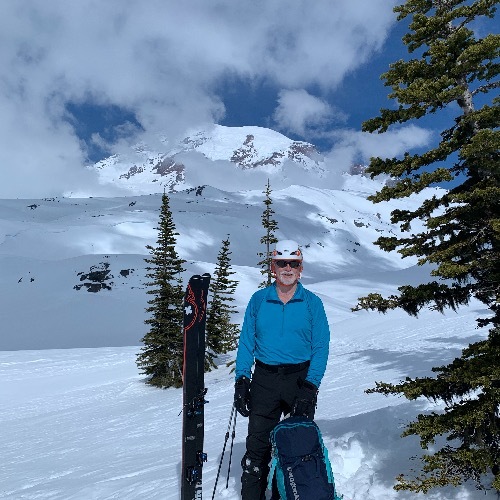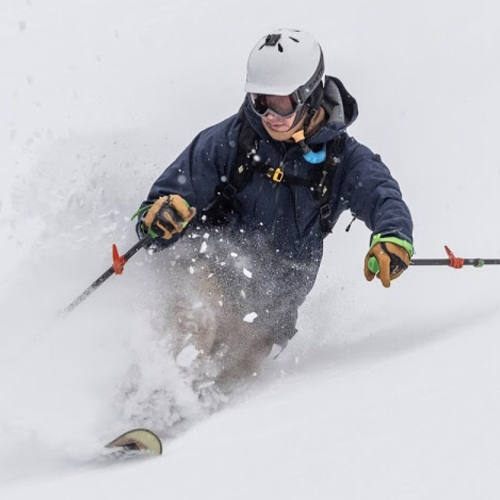- Posts: 4
- Thank you received: 0
Voile Switchback v. Switchback X2?
- danvon
- [danvon]
-
 Topic Author
Topic Author
- Offline
- New Member
-

Thanks.
Please Log in or Create an account to join the conversation.
- Andrew Carey
- [acarey]
-

- Offline
- Elite Member
-

- Posts: 912
- Thank you received: 0
Please Log in or Create an account to join the conversation.
- davidG
- [davidG]
-

- Offline
- Elite Member
-

- Posts: 764
- Thank you received: 0
I have them all (well, X2 is coming on new waxless Vectors - but I understand the premise), and I like them all. Also straight three-pins. What I like about those that require a 'powerful' (weight) input is that I'm reminded (forced) to properly weight that rear foot. And when doing so, I feel like I can charge the line I'm looking at.
The converse is that if you're not liking HH on 4 or 5, you won't do any better with G3 or Switchback. It's about weighting the rear ski...
It's also about the quiver. We all, simultaneously, seek the one-quiver while lasering in on specific setups for specific tasks. That's mostly the skis' job. You can't have too many skis.
I say get the binding that you're most concerned about being able to push. But consider, as well, the basic and lowly unit , cheap and light, that only works well when you can load the back same as front. You know..
Please Log in or Create an account to join the conversation.
- Andrew Carey
- [acarey]
-

- Offline
- Elite Member
-

- Posts: 912
- Thank you received: 0
One caveat about active bindings, especially hardwire types: with the heel retention it is really easy to lapse into using parallel turns instead of tele turns; if that's what you like, fine; it is more work to do a tele turn with an active binding and that also prompts a lapse into the easy parallel turn; 3-pins necessitate good tele technique.
FWIW, just an old codger running his mouth ;D
Please Log in or Create an account to join the conversation.
- Gary Vogt
- [vogtski]
-

- Offline
- Premium Member
-

- Posts: 511
- Thank you received: 8
Please Log in or Create an account to join the conversation.
- Randito
- [Randito]
-

- Offline
- Elite Member
-

- Posts: 960
- Thank you received: 1
Please Log in or Create an account to join the conversation.
- Big Steve
- [Big Steve]
-

- Offline
- Junior Member
-

- Posts: 141
- Thank you received: 0
I'm not familiar with the term "power," as applied to tele bindings, nor do I quite understand what you mean by "input." The commonly used term "active" refers to a binding which: (a) promotes the flex of the rear (uphill) boot's bellows; and (b) aids in keeping the forefoot closer to the rear ski deck. As an ardent (former*) HammerHead #4 - #5 user, I well understand the advantages of a highly active binding. The difference between passive and active tele binders was so immediately obvious to me, I didn't get those who didn't get it. ;DHave never quite understood the 'power' aspect of tele bindings, except that some take more input to function than others, and that input can only come from sufficient weighting of the rear (uphill) ski - a basic tenant [sic] of the telemark technique.
My experience was the converse. When I had passive bindings, I had less control and was more apt to parallel. When I switched to HH's (I was a HH early adopter) I paralleled far less often because tele turns were so much easier than with passive bindings.One caveat about active bindings, especially hardwire types: with the heel retention it is really easy to lapse into using parallel turns instead of tele turns. . .
*My aging body persuaded me to switch to AT gear 5 seasons ago. AT gear is HH#[approaching infinity].
My current rule of thumb: Nordic gear for Nordic terrain. Alpine gear for alpine terrain.
I'll likely get X2's for a waxless meadow skipping rig.
Please Log in or Create an account to join the conversation.
- Kneel Turner
- [Kneel Turner]
-

- Offline
- Senior Member
-

- Posts: 379
- Thank you received: 1
AC says it's more work to do a tele turn with an active binding, but I've found the stiffer/more active setups have made the turns less strenuous. The reason for this is that, in effect, the stiffer the static parts (boot shell/binding lateral stiffness) act like an exoskeleton and the stiffer elastic parts (boot bellows/ binder springs) act like assistance springs to the muscles contracting from turn to turn.
When I compare my old T2's and Targas to my Customs and Rid Stiffs. I can just drop into a proper tele stance and be supported by my "stiff" gear, as opposed to having to hold myself in a static lunge with floppy gear.
So I'd say stiffer(more active) gear is less strenuous, but if you don't use a form that utilizes the benefits of stiffer gear, it's more likely going to feel like its resisting you, not assisting you.
Would you agree with that Andrew?
In any case, my gear has constantly gotten fatter, stiffer, and more active, and each time I've wished I'd gone bigger earlier. So I'd recomend the version 2.
Please Log in or Create an account to join the conversation.
- Andrew Carey
- [acarey]
-

- Offline
- Elite Member
-

- Posts: 912
- Thank you received: 0
Lots of good advice here.
AC says it's more work to do a tele turn with an active binding, but I've found the stiffer/more active setups have made the turns less strenuous. The reason for this is that, in effect, the stiffer the static parts (boot shell/binding lateral stiffness) act like an exoskeleton and the stiffer elastic parts (boot bellows/ binder springs) act like assistance springs to the muscles contracting from turn to turn.
When I compare my old T2's and Targas to my Customs and Rid Stiffs. I can just drop into a proper tele stance and be supported by my "stiff" gear, as opposed to having to hold myself in a static lunge with floppy gear.
So I'd say stiffer(more active) gear is less strenuous, but if you don't use a form that utilizes the benefits of stiffer gear, it's more likely going to feel like its resisting you, not assisting you.
Would you agree with that Andrew?
In any case, my gear has constantly gotten fatter, stiffer, and more active, and each time I've wished I'd gone bigger earlier. So I'd recomend the version 2.
Sorry, I've tried to reply in detail twice and I get to the end of the box and my entire msg disappears. So, I'll keep it short. Everyone's methods and experience differs. I find the most pleasant and least taxing tele experience with 3-pins and brown t-3s on skis with waists of 70 mm or less (Tua Excaliburs, Fisher Outtabounds, Salomon X-adventure) and 3-buckle blue t-2 without a power strap and loosely buckled for my Volkl Snowwolfs. I used the 3-pin harwire and powerstrap skiing crud and the powerstrap lift-served with my Atomic R:EX and 7tms. I arrived at this place after 20 years of tele skiing and skiing with people like Vogtski and Steve Barnett. IMHO, for tele, freedom of the heels rules!
I now ski AT: lighter over all, free pivot on the way up, nearly effortless fixed heel on the way down
Please Log in or Create an account to join the conversation.
- Big Steve
- [Big Steve]
-

- Offline
- Junior Member
-

- Posts: 141
- Thank you received: 0
. . . but I've found the stiffer/more active setups have made the turns less strenuous.
Same experience here, except I'd say "far less strenuous and with much more control."
I find the most pleasant and least taxing tele experience with 3-pins and brown t-3s on skis with waists of 70 mm or less. . . .
I'll agree with "most pleasant," at least on Nordic terrain. There was no need for active bindings in the leather boots days because the forefoot and ankle flexed with ease. Active bindings were designed as a response to high cuffed stiff-bellowed boots which tended to flex at the tippy toe rather than breaking at the ball of foot.
I find the most pleasant and least taxing tele experience with 3-pins and brown t-3s on skis with waists of 70 mm or less. . . .I now ski AT: lighter over all, free pivot on the way up, nearly effortless fixed heel on the way down
There ya go. Nordic gear for Nordic terrain. Alpine gear for alpine terrain.
Please Log in or Create an account to join the conversation.
- davidG
- [davidG]
-

- Offline
- Elite Member
-

- Posts: 764
- Thank you received: 0
...There was no need for active bindings in the leather boots days because the forefoot and ankle flexed with ease. Active bindings were designed as a response to high cuffed stiff-bellowed boots which tended to flex at the tippy toe rather than breaking at the ball of foot.
..
but isn't that, again, just a reflection of the need to weight that foot?
Believe me, I'm a devotee of the active binding when it's about charging the fall line. But I've been putting closer to neutral gear on touring boards, and some of my funnest days (on the down) have been as AC says, heel free as can be with wires in the bag
Please Log in or Create an account to join the conversation.
- Big Steve
- [Big Steve]
-

- Offline
- Junior Member
-

- Posts: 141
- Thank you received: 0
Not quite. Passive vs. active is about whether the weight on the rear foot is distributed more on the toe (passive) or more at a point somewhere behind the ball of foot (active). You can have the same amount of load on the rear ski, but if the center of load is near the toe (passive) you'll have less control than if the center of the load is somewhere at or behind the ball of foot (active). Flexing the bellows is a big factor in getting the load more rearward. A lowrider with a soft flexing boot (e.g., 3-year old Snowpines) won't get much, if any, benefit from an active binding. OTOH, a more upright telemarker with a stiff bellowed boot will benefit greatly from an active binder which promotes the bellows flex. Ankle flex is also a factor and, again, an active binding promotes ankle flex in a stiff cuffed boot.but isn't that, again, just a reflection of the need to weight that foot?
As Steve Barnett breached in his classic instruction treatise, one key to a good telly turn is to have the rear foot near the deck of the ski. That's not a problem for a lowrider with soft low boots in even the floppiest of bindings. Conversely, skiing with only your tippy toe loaded -- a common occurence with a super stiff-bellowed boot with a stiff cuff in a pasive binding -- results in a poor telly turn.
Please Log in or Create an account to join the conversation.
- davidG
- [davidG]
-

- Offline
- Elite Member
-

- Posts: 764
- Thank you received: 0
Please Log in or Create an account to join the conversation.
- Big Steve
- [Big Steve]
-

- Offline
- Junior Member
-

- Posts: 141
- Thank you received: 0
Ah, a fully loaded question ;D. . . because my position is solid and stance is tight. . .
I'm a big boy and I've never been able to flex my F1 bellows that much in a 3 pin.
An individual's COG, thigh length, shin length and overall flexibility are factors. That has become apparent as I haved watched various tele techniques the past 30 years. If your technique and physiology are such that your entire forefoot is loading the ski deck through the entire turn in a passive binding, then you might not notice much benefit from an active binding. (But, then again, you might, as evinced by a lowrider bud of mine who recently got a rig with HH's and skis demonstrably better on them than on his Targas.)
But someone with different physiology may have an equally "solid and tight" stance and good technique, yet not be able get a T1 bellows to flex sufficiently to get the forefoot on the ski deck. That person would very likely benefit from an active binding.
Nearly all skiers with T1's and passive bindings appear to me to be skiing the rear ski with their tippy toes. I came to hate T1 bellows because they were too stiff and switched to T2s and SynerGs.
Please Log in or Create an account to join the conversation.
- davidG
- [davidG]
-

- Offline
- Elite Member
-

- Posts: 764
- Thank you received: 0
Ah, a fully loaded question ;D
..
Yeah, sorry about that. So, it is about loading..?
Please Log in or Create an account to join the conversation.
- Andrew Carey
- [acarey]
-

- Offline
- Elite Member
-

- Posts: 912
- Thank you received: 0
Please Log in or Create an account to join the conversation.
- Andrew Carey
- [acarey]
-

- Offline
- Elite Member
-

- Posts: 912
- Thank you received: 0
... T1 bellows because they were too stiff and switched to T2s and SynerGs.
That is why I liked the 1st edition of the 3-buckle T-2s, they were actually easier flexing than the 1st black and later T-3s. There seemed to be a pathological tele syndrome of bigger boots requiring more active and heavier bindings allowing bigger, heavier skis requiring, then even bigger boots .... .
Of course, this culminate in a reasonably good development: NTN.
Please Log in or Create an account to join the conversation.
- Big Steve
- [Big Steve]
-

- Offline
- Junior Member
-

- Posts: 141
- Thank you received: 0
Please Log in or Create an account to join the conversation.
- rlsg
- [rlsg]
-

- Offline
- Junior Member
-

- Posts: 226
- Thank you received: 0
Side note: I find my newish scarpa t-1s stiff enough that I don't really need the hardwire cable settup to make the boot operate from the ball and I still get lots of leverage (I still ski with the cable on though). I really like the cable though with my t-2xs as it does make those boots "break" further back for the active feel I've become accustomed to.
Please Log in or Create an account to join the conversation.
- rlsg
- [rlsg]
-

- Offline
- Junior Member
-

- Posts: 226
- Thank you received: 0
on the new stuff (and broke lots years and years back) but have never seen nor broken a voile hardwire.
Looks like voile will be plenty active, maybe more than the three-pin hardwire and maybe a tad lighter than the Blacks..
Please Log in or Create an account to join the conversation.
